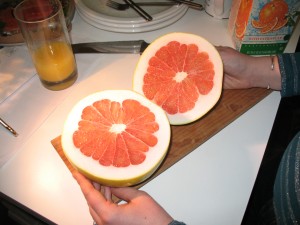What is a pomelo?
April 22, 2011
Trader Joe’s sometimes has interesting things on sale - I remember one of the first times I went to a TJ’s, I bought dried rambutan.
A little while ago, they were selling pomelos, which I don’t think I had ever heard of before. Naturally, I bought one. When I was a kid, the only citrus I knew about were lemons, limes, oranges and grapefruit. Later I learned about mandarins, clementines, blood oranges, tangelos, key limes, and more recently yuzu and buddha’s hand. And now these…
On getting the pomelo home, we cut it open. Disappointingly, it had rather a lot of rind and pith; I’ve gotten used to cutting orange sections out, but I’d guess about half the weight of this pomelo was stuff you can’t eat (unless you’re willing to do some work). The juice and sections had a pretty mild, sweet flavor, which was surprising given that other citrus I’ve tried - particularly the grapefruit, to which the pomelo seemed to bear the greatest resemblance - has a sharp taste that in some cases makes the fruit sections inedible (e.g. lemons).
Pomelo’s species name is “Citrus maxima”, i.e. “the biggest citrus”, which is unsurprising and makes me think that at least some plant taxonomists are not very creative. I didn’t know this, but citrus fruits are botanically berries, in particular a specific type called a hesperidium which is not a “true berry” but close.
Interestingly, though many Americans (well, me anyway) think the fruits we grew up with are standard citrus, most of the stuff we know is hybrids. The grapefruit, for example, is actually a hybrid of a pomelo and an orange. The orange? Unclear, but according to Wikipedia, possibly a hybrid of a pomelo and a mandarin (citrus reticulata). The lemon’s a hybrid too, but nobody seems to know of what.
